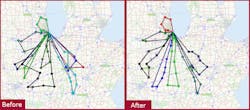You're spending too much or are leaving money on the table. For almost any trucking business, whether it's moving freight and goods, delivering parcels, pickup and delivery, or even just getting trucks and people to a job site, that's the reality if you're not using at least basic route-planning technology. And there are multiple "smart" layers fleets can explore once they go down that avenue.
The more stops your trucks and drivers have, that's only more glaringly the case. A casual drive around or through many metropolitan areas across the United States today won't take long to reveal the limitations of the infrastructure, which can easily leave your drivers stuck in a traffic jam or needing an alternate path to their destination.
Freight demand is growing, and consumers increasingly would rather shop for and purchase goods online, often having them delivered to their door. Anne Goodchild, director of the Supply Chain Transportation and Logistics Center at the University of Washington-Seattle, noted that e-commerce is gaining fast in terms of its share of U.S. retail sales, climbing 16% from 2016 to 2017, to a total of $453.5 billion.
If that growth continues as expected, it would mean that goods to be delivered will more than double in the next five years. So if you've noticed there are weaknesses and problems with the roadways handling the current load of trucks, freight, and passenger cars now, fasten your seat belt—there's a bumpy ride ahead.
Meanwhile, the urban and metropolitan area migration that's been taking place for decades in the United States and around the world means more people live in and around cities, bringing supply and distribution needs with them. It's compounding difficulties in the transportation and logistics equation for any fleet or trucking operation touching those areas.
That's only considering overall traffic volume and congestion and freight/package shipment. Fleets and trucking companies have much more they contend with, like driver shortages exacerbated by very low unemployment rates, rising costs of fuel, tighter regulation of drivers' available service hours thanks to electronic logging devices, and very high consumer and receiver expectations.
Will Salter, CEO of Paragon Software Systems, calls that last point the "Amazonization" of freight and distribution. Paragon develops routing and scheduling software that's used mainly by private fleets with multi-stop needs—companies like third-party logistics providers, bulk transporters, or food service and beverage companies delivering to bars and restaurants.
"In the past, maybe you'd plan a route on a Monday and deliver on Wednesday. That was perfectly acceptable," Salter said. "Now, if you order by a quarter past 4 p.m., with some companies, you can get it this evening. That's becoming much more of an expectation, and it's filtering down to all levels of routing."
He pointed out that the number of fleets using routing and advanced scheduling software tools is, however, "less than you'd expect." That could be a business liability, especially if your competitors are taking advantage of that technology and gaining an edge. And even after you're using route-planning and scheduling tools, that's really only the first step.
"That's great," Salter quipped. "You've then got a set of lovely, shiny routes and you know what each of your drivers are going to do, when they're going to arrive at their stops, how long they're going to take at each of the stops, when they're going to get back to the distribution center—all that good stuff.
"But we all know that once you get out on the road, it's a little bit different sometimes," he continued.
Routing technology has to account for and adapt to real-world, real-time changes. The same road's ability to flow traffic is different at various times of day, days of the week, months of the year, and in response to dynamic situations like the weather or a vehicle collision. The dispatcher or back office of the fleet needs updated information, and often must make route adjustments on the fly.
Don't forget delivery windows. A fleet's customers often may restrict or require appointments for delivery times, so drivers must operate with specific or narrower time windows than trucking companies had once upon a time.
The bottom line: "You've got to maximize your assets, including drivers," Salter said. "You've got to make the absolute most of different elements of what you have to plan. And you can't really do that manually if you have more than a few trucks, quite honestly."
"It's a massive challenge, but also a huge opportunity," he added.
About the Author
Aaron Marsh
Aaron Marsh is a former senior editor of FleetOwner, who wrote for the publication from 2015 to 2019.



